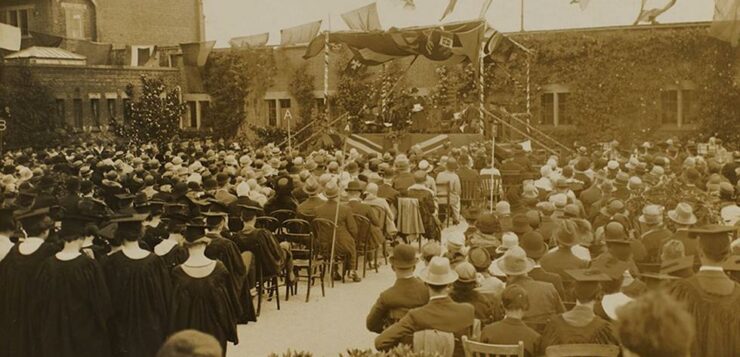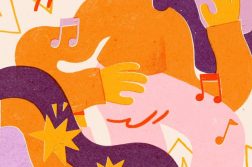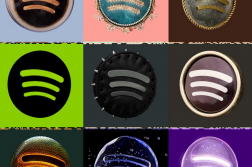As a history student, I have been naturally drawn to understanding the lives of those who have studied before me. Investigating the “student experience” and how it has changed over the decades intrigues me. My definition of the student experience is the academic & social elements of student life as well as coping with being away from home. Looking at periods such as the 1930s, 60s and 80s will demonstrate the transformation through time here at Southampton. I won’t just be looking at the past, but I will contrast what current experiences are and will suggest what future students could expect.
If we begin by travelling back in time to the 1930s, the institution was named ‘Southampton University College’, only gaining official university status in 1952. Highfield Campus itself was opened in 1919, but today’s campus would be largely unrecognisable for students from that time; only the Hartley Library and a few other campus buildings have remained the same.
Imagine the social and academic life of a student back then. For those who could afford the fees, there was an opportunity to rub shoulders with fellow academics and be taught be dedicated teachers. Teaching would have been carried out on blackboards by lecturers donning their mortarboards.
Dramatic events such as the ‘Great War’ and a global financial downturn would also have influenced the inter-war student atmosphere. The growing talk of war probably overshadowed students’ social life; letters home would have been the primary form of keeping in touch. The lack of instant communication with parents would have been difficult for many students. In a sense it was a much simpler time and was no doubt filled with fun. Freshers would have still involved students downing pints and meeting new people!
By the 1960s, counterculture was impacting students’ lives across the country, including those at Southampton. Lecturers would have encouraged their students to use their first names, hair would have been grown well down beyond the collar and it was a time of protest and ‘free love’. There was a sense in the lecture room that it was important to rebel against established viewpoints and challenge the status quo. Additionally, a growing sentiment that education should be more widely available was reinforced in 1962 when the government agreed to cover the cost of tuition for students, a policy that lasted until 1998.
Some students angered by the Vietnam War might have taken to the streets of Central Southampton, joining the marches held in 1967. Others might have been in the audience when the Student Union hosted a Pink Floyd gig in 1969. This was the decade of student protest across the world and the rise of rock and roll bands that provided a soundtrack that older generations could not relate to. Those wanting to call home about new experiences would have had to queue at the phone box and make sure they had enough change.
Now onto the 1980s. What a time to be a student! Not just for the fashion, music, and politics but also for the advances in technology which made studying easier. Academically, students had the option to write up essays on word processors and microcomputers, but they were still going to the library, withdrawing physical books, and making handwritten notes. Technological innovation also allowed students to relax using items such Walkmans and ZX Spectrums.
Politically, the UK had its first female prime minister, Margaret Thatcher. The events of the Falklands War, domestic unrest regarding the miners’ strikes and protests against the new Poll Tax would have been a talking point amongst students. The fashion and music of the 80s was exciting, with synthesisers and drum machines defining a new sound, and the development of sub-cultures, including one of my personal favourites: goth. In a pre-internet decade, the payphone was still the only option for communicating with friends and parents.
So, how does the student experience today compare with the past? The most obvious difference is the advancement of technology and social media. The internet has become vital for studying at university, with lectures and reading material always available. Having said that, a student from the 1930s would still understand the essential format of lectures and seminars.
Connectivity for modern students is far greater; student life today relies on the ability to text course mates and friends, arrange meetups, and talk with societies. Even 30 years ago, a student would depend on seeing someone in person or occasionally having access to a telephone. There are of course negative aspects of social media, but a growing understanding of mental health and the importance of wellbeing are a notable feature of modern student life.
Another intriguing point of change has been the difference in tuition fees and the cost-of-living. Rates of student debt and tuition fees are the worst they have ever been, in stark contrast to period when university was paid for by the government, and students were given grants. This has made the decision to commit to university more pressured, with a feeling of your own investment in time and money to the degree. For me personally, one of the bleakest differences is the cost-of-living crisis. I find the fact that a pint was £1.20 in 1990 utterly astounding compared to modern prices of £5 upwards. Think of how many more drinks I could buy! Students still go out on nights drinking and enjoying themselves, but at a much higher cost.
Casting my eye into the crystal ball, what do I predict for future students? One certainty is that artificial intelligence and virtual reality will play a highly significant role. If we analyse the impact of the internet, I can’t even imagine how these new forms of technology will transform studying. I think in 20 years, students will still be attending lectures and seminars, but the process of learning will go through another dramatic change. The past has shown that although the hairstyles, fashion and politics change many fundamentals remain the same. So, do not worry because freshers will always be there, and students will always have to do the reading!




